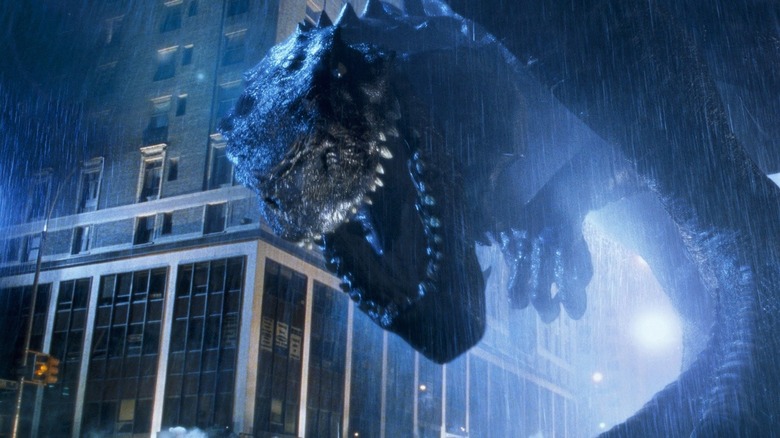The Writer Of 1998's Godzilla Knows Where They Went Wrong With The Movie
With the 1995 release of "Godzilla vs. Destoroyah," Toho ended the Heisei era of their Godzilla films in earnest and, in an unprecedented move, handed the reigns of their most popular monster over to TriStar Pictures for a proposed three-picture deal. Rather than make a typical mid-budget film, TriStar elected to make a major summer tentpole, pouring about $150 million into production and hiring "Independence Day" director Roland Emmerich. The film was a 139-minute FX bonanza that reimagined Godzilla as a sleek, square-jawed iguana that terrorized New York City. The monster was small enough to hide inside skyscrapers and spent large portions of the film offscreen in New York's sewers.
The script was more comedic than awe-inspired, populated by chattering Noo Yawk characters whose reactions to Godzilla were more along the lines of "weary acceptance" than awe. The cast would end up featuring Matthew Broderick, Maris Pitillo, Jean Reno, Kevin Dunn, and "The Simpsons" veterans Hank Azaria and Harry Shearer.
"Godzilla" was notoriously panned (it bears a 20% approval rating on Rotten Tomatoes), and, when it was released, was soon regarded as one of the worst films of the year. The Golden Raspberries nominated it in five categories and it was mocked on an episode of "South Park." Toho was also disappointed by the film, and would later claim that Emmerich's monster was merely a creature that Americans mistook for Godzilla. This one was, instead, a monster they rechristened "Zilla" in 2004's "Godzilla: Final Wars."
Emmerich co-wrote the "Godzilla" screenplay with longtime collaborator Dean Devlin, and Devlin thinks he knows what happened. He looked back over the film in a 2023 retrospective with Inverse and found that he and Emmerich stumbled when introducing the characters. By the time the audience got to know them, he said, the film was half over.
Dean Devlin remembered how movies are supposed to work
"Godzilla" opens with a lot of portentous scenes of monster mayhem, indicating that, yes indeed, a monster will inevitably appear. Tactfully, the filmmakers keep the creature offscreen for a long time. This was an approach that Emmerich took with "Independence Day" as well, showing how many people all over the globe are reacting to a slow-moving alien invasion before introducing the film's key players. Devlin felt that, with a "Godzilla" movie, it might have been wiser to get to the key players a little more quickly. He also noted that the tone was all over the place. He said:
"Movies normally start out with a lot of setup of who the characters are and what the motivations are, and then throw you into the story. [...] We had this idea of, what if we just throw people into the story and really set up the characters in the second act? Which was a giant mistake. [...] Things that should have been funny or things that should have been emotional felt stupid because it didn't make sense to you, watching it. [...] So there was this frustration and anger."
So Devlin and Emmerich needed to more precisely choose whether their film was a comedy or not, and then, on that basis, get to the human characters' drama that much more quickly. The Inverse article pointed out that the Pitillo character isn't even introduced until about 20 minutes in. They could have more efficiently built their ensemble. To offer an editorial, I think the tone was the bigger issue. Devlin and Emmerich could have chosen to be less "funny," or at least less "whimsical," and made a better picture.
Is Godzilla a hero or a villain?
It's also important to remember that Godzilla — with a few exceptions — has a lot of personality. In the 1960s Showa-era films, Godzilla went from being an echo of Nuclear devastation into a tired-out, experienced bouncer, compelled to fight all the interloper monsters who would dare invade the party club, a.k.a. Japan. By "Destroy All Monsters" in 1968, Godzilla was a symbol of Japanese national pride, a monster who stood tall and ready, eager to fight off outsiders. Very occasionally, Godzilla was villainous and destructive, seen only as a force of evil. Only in 2016's "Shin Godzilla" and the 2018 animated films is Godzilla truly a neutral force of nature.
Devlin noted that he and Emmerich wanted their Godzilla to be an iguana with only animal intelligence and no sense of agency. In 1998, Devlin reconsidered, this was an unwise move. Most Godzilla fans were used to Godzilla having a point of view, a personality, and even motivation for fighting. In making the monster a big lizard, audiences only had the limp semi-comedic characters to latch onto. Devlin said:
"Roland had an idea that I think was very interesting on an intellectual level, which was that Godzilla should neither be a hero nor a villain; that he's simply a really large lizard. [...] I think on this type of movie, especially with the massive fan base of Godzilla, we really needed to decide if we were doing a movie where Godzilla was the villain or Godzilla was the hero. [...] I think I should have realized that you can't be ambivalent about the title character [...] Right now it seems so obvious."
Devlin and Emmerich thought it was cool at the time, but ... well, hindsight is 20/20.
